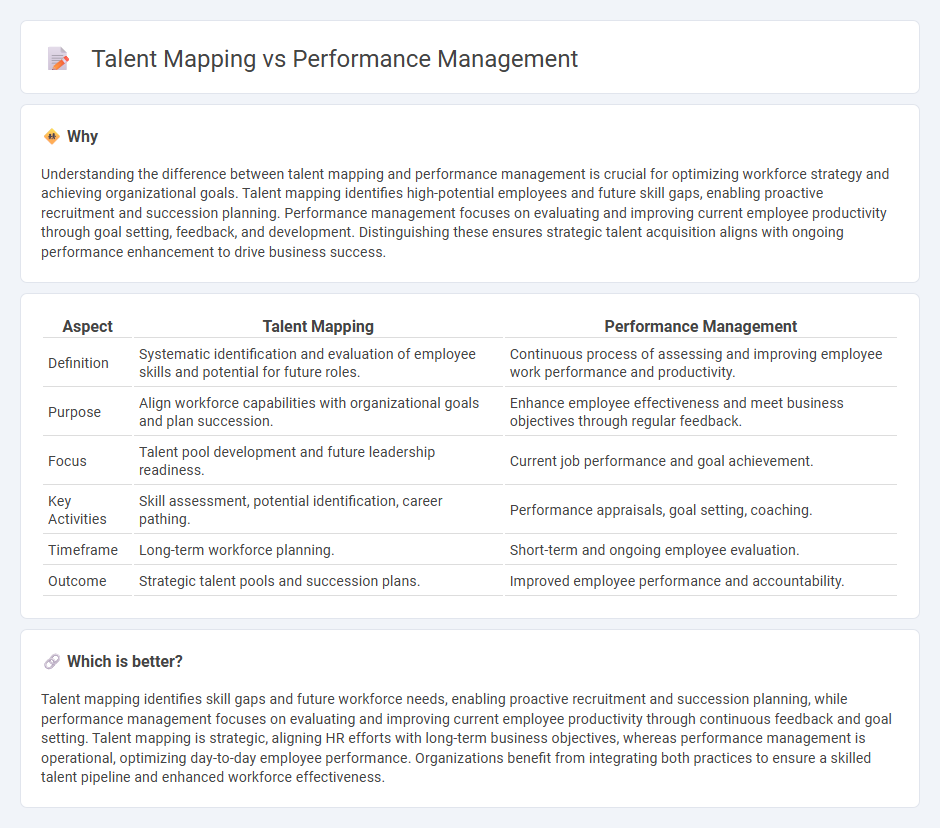
Talent mapping identifies skill gaps and future workforce needs by analyzing employee capabilities and market trends, enabling strategic recruitment and succession planning. Performance management tracks employee productivity and goal achievement through regular evaluations, fostering continuous development and alignment with organizational objectives. Explore in-depth insights on how talent mapping and performance management drive effective human resource strategies.
Why it is important
Understanding the difference between talent mapping and performance management is crucial for optimizing workforce strategy and achieving organizational goals. Talent mapping identifies high-potential employees and future skill gaps, enabling proactive recruitment and succession planning. Performance management focuses on evaluating and improving current employee productivity through goal setting, feedback, and development. Distinguishing these ensures strategic talent acquisition aligns with ongoing performance enhancement to drive business success.
Comparison Table
| Aspect | Talent Mapping | Performance Management |
|---|---|---|
| Definition | Systematic identification and evaluation of employee skills and potential for future roles. | Continuous process of assessing and improving employee work performance and productivity. |
| Purpose | Align workforce capabilities with organizational goals and plan succession. | Enhance employee effectiveness and meet business objectives through regular feedback. |
| Focus | Talent pool development and future leadership readiness. | Current job performance and goal achievement. |
| Key Activities | Skill assessment, potential identification, career pathing. | Performance appraisals, goal setting, coaching. |
| Timeframe | Long-term workforce planning. | Short-term and ongoing employee evaluation. |
| Outcome | Strategic talent pools and succession plans. | Improved employee performance and accountability. |
Which is better?
Talent mapping identifies skill gaps and future workforce needs, enabling proactive recruitment and succession planning, while performance management focuses on evaluating and improving current employee productivity through continuous feedback and goal setting. Talent mapping is strategic, aligning HR efforts with long-term business objectives, whereas performance management is operational, optimizing day-to-day employee performance. Organizations benefit from integrating both practices to ensure a skilled talent pipeline and enhanced workforce effectiveness.
Connection
Talent mapping provides a strategic overview of employee skills and potential, enabling targeted talent development within Performance Management systems. Performance management uses this data to set personalized goals, monitor progress, and identify skill gaps. Together, they enhance workforce planning, employee engagement, and succession planning in Human Resources.
Key Terms
**Performance management:**
Performance management systematically evaluates and improves employee performance through goal setting, continuous feedback, and regular appraisals, driving organizational success and individual growth. It integrates key metrics and performance data to identify skill gaps and enhance productivity across teams. Discover how mastering performance management can elevate your workforce effectiveness and business results.
Key Performance Indicators (KPIs)
Performance management revolves around setting, measuring, and analyzing Key Performance Indicators (KPIs) to assess employee productivity and align individual goals with organizational objectives. Talent mapping uses KPIs to identify skills gaps, future leaders, and strategic workforce planning, ensuring the right talent is positioned for critical roles. Discover more about how leveraging KPIs can optimize both performance management and talent mapping strategies.
Continuous feedback
Performance management centers on continuous feedback to enhance employee skills, align goals, and boost productivity through regular evaluations and real-time input. Talent mapping uses continuous feedback to identify skill gaps and potential career paths, ensuring a strategic fit between employee capabilities and organizational needs. Discover how integrating continuous feedback transforms both performance management and talent mapping for optimal workforce development.
Source and External Links
What Is Performance Management? The Complete Guide - AIHR - Performance management is an ongoing process where managers and employees regularly communicate to assess and review job responsibilities using methods like SMART goal setting, continuous feedback, and real-time performance discussions to foster professional growth and maximize organizational contribution.
Performance Management - KU's Human Resources - Performance management is a continuous process of communicating and clarifying job duties, priorities, and expectations through goal-setting, regular feedback sessions, and development planning aligned with organizational goals throughout the year.
Performance management that puts people first - McKinsey - Effective performance management systems help employees continuously develop, provide career clarity, align with organizational strategy, and improve business outcomes by incorporating elements like goal setting, reviews, ongoing development, and aligned rewards focused on people and culture.
 dowidth.com
dowidth.com